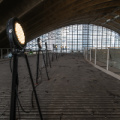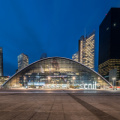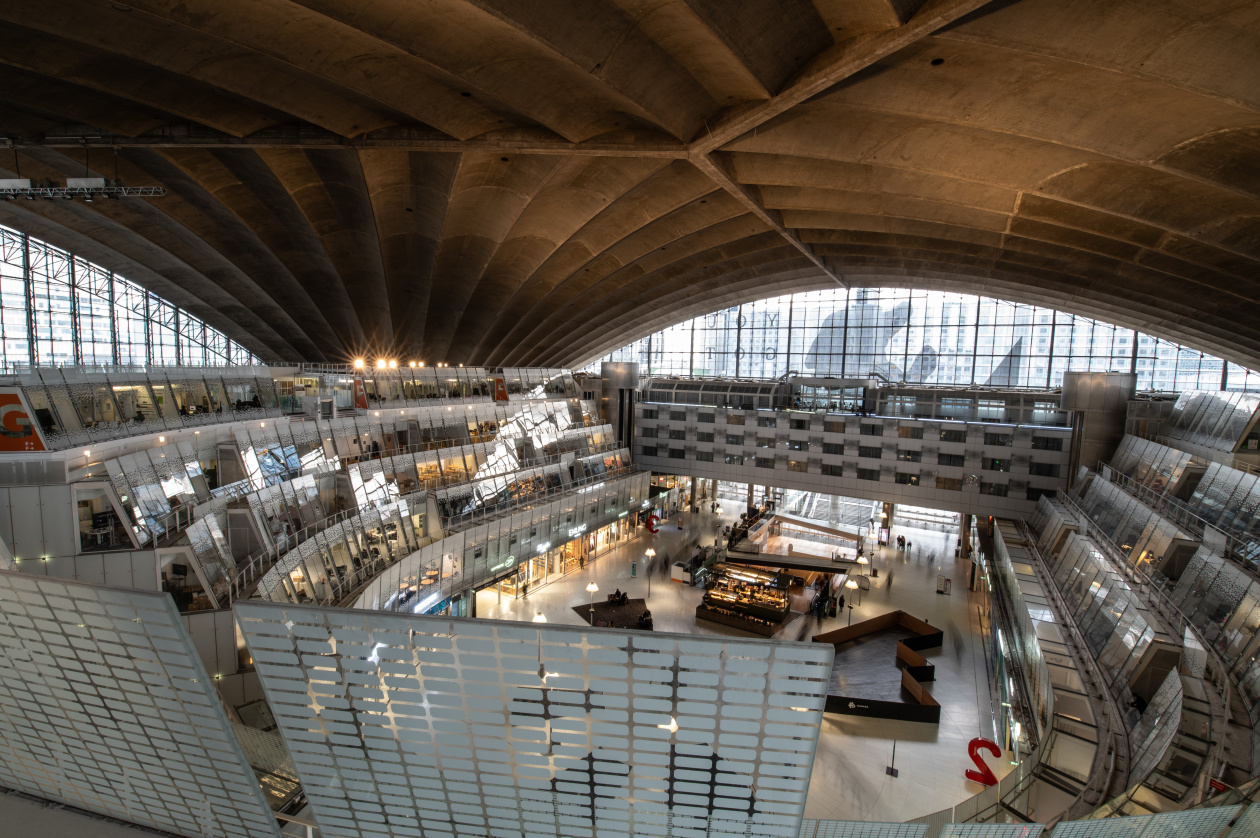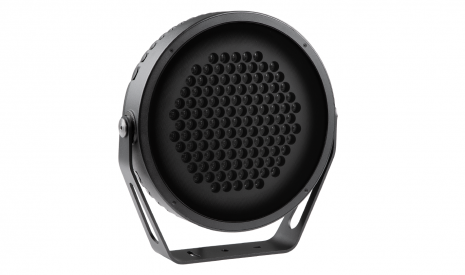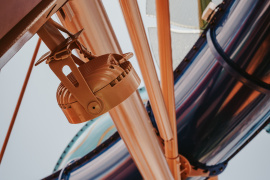Project Details
The famous and distinctive folded concrete triangular-shaped vaulted ceiling of the CNIT (National Centre for Industry and Technology) building at the La Défense CBD in Paris … has been newly, beautifully, and subtly illuminated with Anolis Calumma XL SC LED luminaires.
This invigorating new lighting project is part of a modernisation initiative led by architect Jean-Luc Crochon of Cro&Co Architecture who approached BOA Light Studio to create a plan to enhance the underside of the ceiling with lighting.
The scheme is designed to bring a ‘living-breathing’ resonance to the structure, pulling the texturing, nuance and luminance of daylight and the sky outside into the shell-like atrium space of the building that now houses multiple shops, retail outlets and offices as well as a hotel and convention centre.
The brief from the client, the Unibail-Rodamco-Westfield management team who manage the property, was to “bring in more light”.
The imposing concrete ‘vault’ as it is known, is 46 metres high and each side is 218 meters long, forming part of an equilateral triangle. Three glass façades – with convex curves on two sides – each span 206 meters and allow daylight and sun to stream through into the space.
The roof rises from three pillars, connected to the apex of a triangle beneath the reception hall. Its 6-centimetre-thick double shell is the last intact element of the monumental post-World War II reconstruction period architecture that was characteristic of the initial La Défense building scheme.
Inaugurated in 1958, the vault has seen two major renovations, in 1989 and 2009.
The new lighting concept chosen to deliver the best results was to illuminate the vault indirectly from the vantage points of all the roofs of the highest offices inside. "We needed plenty of luminous power to assist with this, and selected the largest Anolis Calumma fixtures, the Calumma XL SC as their 11,000-lumen output gave us the punch needed plus an excellent quality of light,” explained Nedir Benkhelifa of BOA Light Studio.
They wanted to emphasise relief and bring out the sublime and ethereal presence of the vault, noted Nedir, adding that it was more about creating a ‘sensation’ – almost an illusion of light – through ‘luminous presence’, than directly lighting the ceiling surface.
“Light moods are better when perceived. Done right, it's a psychological phenomenon that improves the overall perception of the place” he noted.
Anolis product specialist Bruno Francois from Anolis France recalled how their request coincided with the launch of Calumma, a new range of LED luminaires ideal for installation projects needing spot, accent, or flood lighting solutions. The fixture’s optical design utilises 37 high efficacy single-chip LEDs, available with optional LED colour variants and various beam angles.
In February and March 2023, tests were undertaken on site with eight Calumma XL SC fixtures that were placed close to the final proposed locations to give realistic results.
In two sessions over a period of fifteen days, BOA studio’s lighting designers meticulously measured the levels and observed the effects, an exercise that confirmed several aspects of this indirect lighting idea that were difficult or impossible to gauge using 3D modelling.
From these tests, they selected the fixture’s native 10° beam optics, tweaked the final fixture positioning, validated the imagined colour temperatures, and tested the lighting effect of the linear optics.
The Calumma’s 8-channel control with CT whites and magenta-green colour adjustments allowed the BOA team to quickly and easily refine and perfect the desired shades during the testing.
"It is so simple to create different shades at this stage," enthused Nedir. "We didn't require the lighting to be like a disco, or going red for Christmas, etc., so we chose an elegant variable white signature look."
Following the onsite demonstrations and testing, the Calumma XC SC was confirmed as the best fixture choice for the project, and Unibail-Rodamco-Westfield placed the order for the tunable white versions - 2,700 K and 4,000 K - that were manufactured at the Anolis factory in the Czech Republic.
Three rows of 8 x Calumma XC SCs mounted on metal tripods are located on the office roof section ‘islands’ towards the end of each vault arch and as they start to descend. Illuminating the ceiling and creating the textured relief that BOA envisioned, they reveal the grooves, detail, and linearity of the concrete shell by creating soft shadows.
The 1.2-metre-high eye-level stands – in smart graphite black (RAL 9011), manufactured by the installer, Citeos – allow the lighting to be masked from the terrace guardrails on each section.
The Calumma bodies are fabricated from die-cast aluminium and rated IP67 and IK10 and are designed to withstand humidity and all temperatures, both outdoors and indoors.
They are programmed into the two shades of white. Nedir decided to work with these warmer tones, avoiding anything too cold, because the concrete is already cold and very raw, so lighting with cooler whites during the testing revealed material defects and colour differences that were somewhat prosaic!
"We created effective ‘slow breathing’ movements of light, as if clouds above are entering the building and we were immersed, playing with these ripples of light similar to the movement of clouds passing in front of the sun and the atmospheric shift you experience when that happens,” he related.
The fixtures are not all on simultaneously. One-third are turned off while two-thirds are working, and sometimes it's the opposite, with two-thirds off and one-third on. These short sequences maintain a sensation of brightness over a cycle of approximately 15 minutes.
The 24 x Anolis luminaires are controlled via a Pharos system using DMX / RDM. Lumières Utiles handled the control aspect of the project for BOA and programmed a series of preset lighting sequences for the installation.
The lighting is almost invisible from some angles of the CNIT’s inner esplanade, but these imperceptible waves of luminance reveal the ceiling with great simplicity … and empathy, imagination and magic-of-the-mind completes the picture!
About CNIT
CNIT – the Centre of New Industries and Technologies – was the first building developed at La Défense, now a thriving and gleaming urban metropolis and CBD serving the west of Paris. The idiosyncratic shape was dictated by the triangular plot of land on which it stands, originally occupied by the old Zodiac Aerospace factory.
The famous roof or ‘vault’ comprises 3 “fans” each made from 18 spindles deployed from 3 concrete 84 tonne abutments which are cast up to 12 meters deep. Although the vault is self-supporting, 44 steel cable ties help maintain its inflated sail shape. Still a world record breaking span and an acclaimed feat of structural engineering, the vault features two 6.5 cm thick concrete shells separated by a void, in a design like that of an airplane wing.
Its award-winning architects were Robert Camelot, Jean de Mailly and Bernard Zehfuss working in partnership with talented structural engineer Nicolas Esquillan who invented and shaped the double self-supporting reinforced concrete shell with stiffeners.
While CNIT has undergone the two major restructurings since opening in 1958, the famous roof has remained, and has now entered a new phase of recognition and architectural significance with the new Anolis lighting scheme.
Photo Credit: La Chouette Photo - Olivier Hannauer
This invigorating new lighting project is part of a modernisation initiative led by architect Jean-Luc Crochon of Cro&Co Architecture who approached BOA Light Studio to create a plan to enhance the underside of the ceiling with lighting.
The scheme is designed to bring a ‘living-breathing’ resonance to the structure, pulling the texturing, nuance and luminance of daylight and the sky outside into the shell-like atrium space of the building that now houses multiple shops, retail outlets and offices as well as a hotel and convention centre.
The brief from the client, the Unibail-Rodamco-Westfield management team who manage the property, was to “bring in more light”.
The imposing concrete ‘vault’ as it is known, is 46 metres high and each side is 218 meters long, forming part of an equilateral triangle. Three glass façades – with convex curves on two sides – each span 206 meters and allow daylight and sun to stream through into the space.
The roof rises from three pillars, connected to the apex of a triangle beneath the reception hall. Its 6-centimetre-thick double shell is the last intact element of the monumental post-World War II reconstruction period architecture that was characteristic of the initial La Défense building scheme.
Inaugurated in 1958, the vault has seen two major renovations, in 1989 and 2009.
The new lighting concept chosen to deliver the best results was to illuminate the vault indirectly from the vantage points of all the roofs of the highest offices inside. "We needed plenty of luminous power to assist with this, and selected the largest Anolis Calumma fixtures, the Calumma XL SC as their 11,000-lumen output gave us the punch needed plus an excellent quality of light,” explained Nedir Benkhelifa of BOA Light Studio.
They wanted to emphasise relief and bring out the sublime and ethereal presence of the vault, noted Nedir, adding that it was more about creating a ‘sensation’ – almost an illusion of light – through ‘luminous presence’, than directly lighting the ceiling surface.
“Light moods are better when perceived. Done right, it's a psychological phenomenon that improves the overall perception of the place” he noted.
Anolis product specialist Bruno Francois from Anolis France recalled how their request coincided with the launch of Calumma, a new range of LED luminaires ideal for installation projects needing spot, accent, or flood lighting solutions. The fixture’s optical design utilises 37 high efficacy single-chip LEDs, available with optional LED colour variants and various beam angles.
In February and March 2023, tests were undertaken on site with eight Calumma XL SC fixtures that were placed close to the final proposed locations to give realistic results.
In two sessions over a period of fifteen days, BOA studio’s lighting designers meticulously measured the levels and observed the effects, an exercise that confirmed several aspects of this indirect lighting idea that were difficult or impossible to gauge using 3D modelling.
From these tests, they selected the fixture’s native 10° beam optics, tweaked the final fixture positioning, validated the imagined colour temperatures, and tested the lighting effect of the linear optics.
The Calumma’s 8-channel control with CT whites and magenta-green colour adjustments allowed the BOA team to quickly and easily refine and perfect the desired shades during the testing.
"It is so simple to create different shades at this stage," enthused Nedir. "We didn't require the lighting to be like a disco, or going red for Christmas, etc., so we chose an elegant variable white signature look."
Following the onsite demonstrations and testing, the Calumma XC SC was confirmed as the best fixture choice for the project, and Unibail-Rodamco-Westfield placed the order for the tunable white versions - 2,700 K and 4,000 K - that were manufactured at the Anolis factory in the Czech Republic.
Three rows of 8 x Calumma XC SCs mounted on metal tripods are located on the office roof section ‘islands’ towards the end of each vault arch and as they start to descend. Illuminating the ceiling and creating the textured relief that BOA envisioned, they reveal the grooves, detail, and linearity of the concrete shell by creating soft shadows.
The 1.2-metre-high eye-level stands – in smart graphite black (RAL 9011), manufactured by the installer, Citeos – allow the lighting to be masked from the terrace guardrails on each section.
The Calumma bodies are fabricated from die-cast aluminium and rated IP67 and IK10 and are designed to withstand humidity and all temperatures, both outdoors and indoors.
They are programmed into the two shades of white. Nedir decided to work with these warmer tones, avoiding anything too cold, because the concrete is already cold and very raw, so lighting with cooler whites during the testing revealed material defects and colour differences that were somewhat prosaic!
"We created effective ‘slow breathing’ movements of light, as if clouds above are entering the building and we were immersed, playing with these ripples of light similar to the movement of clouds passing in front of the sun and the atmospheric shift you experience when that happens,” he related.
The fixtures are not all on simultaneously. One-third are turned off while two-thirds are working, and sometimes it's the opposite, with two-thirds off and one-third on. These short sequences maintain a sensation of brightness over a cycle of approximately 15 minutes.
The 24 x Anolis luminaires are controlled via a Pharos system using DMX / RDM. Lumières Utiles handled the control aspect of the project for BOA and programmed a series of preset lighting sequences for the installation.
The lighting is almost invisible from some angles of the CNIT’s inner esplanade, but these imperceptible waves of luminance reveal the ceiling with great simplicity … and empathy, imagination and magic-of-the-mind completes the picture!
About CNIT
CNIT – the Centre of New Industries and Technologies – was the first building developed at La Défense, now a thriving and gleaming urban metropolis and CBD serving the west of Paris. The idiosyncratic shape was dictated by the triangular plot of land on which it stands, originally occupied by the old Zodiac Aerospace factory.
The famous roof or ‘vault’ comprises 3 “fans” each made from 18 spindles deployed from 3 concrete 84 tonne abutments which are cast up to 12 meters deep. Although the vault is self-supporting, 44 steel cable ties help maintain its inflated sail shape. Still a world record breaking span and an acclaimed feat of structural engineering, the vault features two 6.5 cm thick concrete shells separated by a void, in a design like that of an airplane wing.
Its award-winning architects were Robert Camelot, Jean de Mailly and Bernard Zehfuss working in partnership with talented structural engineer Nicolas Esquillan who invented and shaped the double self-supporting reinforced concrete shell with stiffeners.
While CNIT has undergone the two major restructurings since opening in 1958, the famous roof has remained, and has now entered a new phase of recognition and architectural significance with the new Anolis lighting scheme.
Photo Credit: La Chouette Photo - Olivier Hannauer


